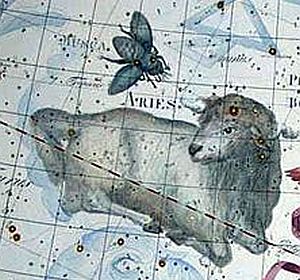Wikipedia
R.H. Allen:
Star Names
Ian Ridpath:
Star Tales
Astronomy Facts
Lost
Constellations
SkyEye
|
Wikipedia |
R.H. Allen: Star Names |
Ian Ridpath: Star Tales |
Astronomy Facts |
Lost Constellations |
SkyEye |


|
|
Star LoreMusca BorealisThe Northern Fly |
|


|
Musca Borealis is a now obsolete constellation in the northern hemisphere, named in the late 1600s by Johannes Hevelius. In 1612, Dutch-Flemish astronomer and cartographer Petrus Plancius designed six new constellations in the northern hemisphere and along the celestial equator. They were first shown an a globe made by Plancius and later, in 1624 on a star map in Usus Astronomicus Planisphaerii Stellati by Jakob Bartsch. |

The stars used to create Musca Borealis are steeped in the history of now obsolete constellations.
 In 1612, Dutch cartographer Petrus Plancius created - among other constellations - a constellation called Apes (plural of Apis, which is Latin for bee) out of the faint stars 33, 35, 39 and 41 Arietis in the northern part of the constellation Aries.  In 1624, the formation was renamed Vespa (Latin for wasp) by Jakob Bartsch.  In the star atlas Firmamentum Sobiescianum by Polish astronomer Johannes Hevelius, published in 1690, it was named Musca (Latin for fly).  This should not be confused with the southern hemisphere constellation Musca, created in 1603 by Keyser and de Houtman.  For this very reason, in later star maps, the constellation appeared as Musca Borealis (Northern Fly), while the Southern Fly was named Musca Australis.  In 1679, Augustin Royer used the same stars for his creation of Lilium, the Lily, referring to the fleur-de-lis, the symbol of French royalty.  In 1922, when the IAU settled on the 88 modern constellations, the stars of Apes / Vespa / Musca Borealis / Lilium were reunited with those of Aries. The southern constellation Musca Australis became simply Musca.  Sources: Wikipedia, SkyEye, Ian Ridpath |
 Musca and Aries in Uranographia
Musca and Aries in Uranographia
|



|
Back to Star Lore |

Back to Obsolete |

Back Plancius' |
Back to Space Page |
Back to English |
 Back to Start Page |